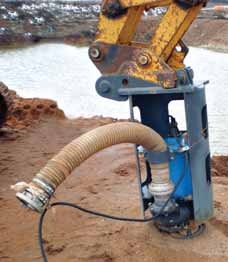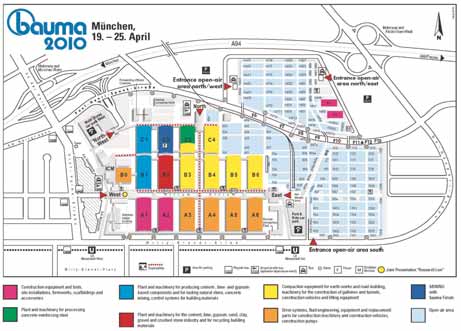
Mining Grows in Importance for Bauma 2010
With traditional construction markets slumping, mining and mineral processing will
be one of the bright spots for the largest equipment exposition
By Steve Fiscor, Editor-in-Chief

bauma 2010 is fully booked and the exhibition space available has grown by another 15,000 m2. In total, bauma 2010 will take up 555,000 m2 of exhibition space. The organizers expect 3,000 exhibitors. In 2007, bauma had 3,002 exhibitors from 49 countries on 540,000 m2 of space, and more than 500,000 visitors from 191 countries.
As well as the high level of international participation, in terms of both exhibitors and visitors, bauma benefits from Messe München’s strong international network of associations and sales partners. Another key reason for the success of bauma is the city in which it is held: Munich. Not only does the New Munich Trade Fair Centre offer an excellent infrastructure and the necessary capacity, but Munich itself has great flair and appeal, and first-class transport links.
“Right after the last bauma in 2007 we started planning for the next one,” said Dittrich. “In particular we have been working on transport and infrastructure improvements. We commissioned the construction of a new entrance building at the northwest of the exhibition center, right next to the multi-story car park. This was recently completed and is now open. It is expected that this new entrance will relieve pressure on the busy West Entrance [marked in purple on the site plan]. We have also made provisions for temporary entrances on the open-air site, which are only being planned and set up for bauma.”
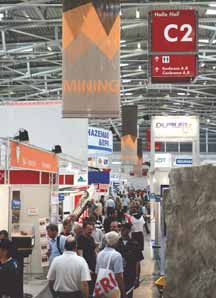
Times Change
Along with the economic downturn, a
steep drop in demand for construction
equipment occurred suddenly worldwide.
“Manufacturers of construction
equipment are used to seeing fluctuations
and therefore know how to handle
them,” said Dr. Christof Kemmann,
CEO, BHS-Sonthofen GmbH; chairman,
The “Mining Hall” C2 also hosts the Bauma Forum. VDMA; and chairman, bauma advisory board. “However, this time, the scale as
well as the speed were unique.”
Despite these trends, the fair is fully
booked, Kemmann explained, and this
might be an important indicator of the
mood and situation the industry finds
itself in.
During 2009, the companies belonging to the VDMA bottomed out. “Throughout that entire year, their amount of incoming orders and industry- wide sales dropped by about 50% on average; making the current volume equal to 2005 figures,” Kemmann said. The fact that the numbers of orders in the field of construction equipment and machinery have decreased in 2009 will only become visible in 2010, as lead times have become significantly longer also. Many a manufacturer will have to face a drop in sales and capacity utilization this year.”
For the mining machinery industry, 2009 was a record year in terms of sales for the VDMA. “However, the number of incoming orders fell immensely also,” Kemmann said. “Therefore, particularly in 2010, problems with regard to capacity utilization are to be expected. However, the industry hopes to maintain its overall turnover achieved in 2009 also in the running year. There are signs that at least some of the orders that were cancelled last year because of the economic crisis, will be filled this year.”
There is no reason to be euphoric whatsoever, Kemmann explained, and companies are preparing themselves for a lean period.
The long term forecasts for the construction, building material, mining as well as the machinery industry worldwide are positive. This is thanks to rapidly growing markets in Asia and other regions, such as Brazil.
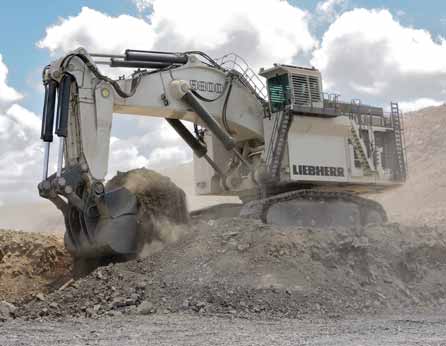
A large number of new and further developed products are the main focus of interest on the new Liebherr stand. The list of exhibits includes 11 mobile cranes, six crawler cranes and hydraulic excavators, three large rotary drilling units, nine tower cranes, six mobile excavators, seven crawler excavators and wheel loaders, four crawler tractors and loaders, two telescopic handlers, a truck mixer, two mixing plants and a large mining truck. The Liebherr program of new products is rounded off by two world premieres: an innovative bulk material handler and the 282C centersteered mining class haul truck.
As reported in the Engineering & Mining Journal survey of German Mining Technology (September 2009, pp 46-47), the TI 264 truck has been undergoing mine site testing while the T282C mine truck, which features a Liebherr IGBT based electronic drive system, is also being tested. The new R9100 small mining excavator, weighing in at 107-108 mt, is presently being tested at Liebherr-France and field testing will follow. The new excavator will be displayed at bauma 2010. The R9800 backhoe has been on site in Australia since December and Liebherr says the machine’s performance is amazing, exceeding the manufacturer’s productivity expectations.
In addition to the R9800, Liebherr will also have an R954C SHD hydraulic excavator on the stand. With a service weight of approximately 62 mt, it develops a crowding force of 435 kN (44.3 mt) and a breakaway force of up to 355 kN (36.2 mt). The excavator’s maximum crowding length is 3.38 m and its discharge height is 6.30 m.
In addition to mining equipment, Liebherr’s newly developed energy storage cylinder is one of three contenders in the Bauma Innovations Components category. The new Liebherr energy storage cylinder is a gas-filled cylinder designed specifically for use on material handling equipment, with the main emphasis on overall efficiency of the hydraulic system and economical machine operation. The cylinder partially compensates for the weight of the machine’s working equipment. It enables energy to be stored more effectively and increases the overall efficiency of the power hydraulic system. As the hydraulically-powered equipment is lowered, the gas in the storage cylinder is compressed. When the next lifting movement starts, the stored energy assists the action of the two boom lifting rams so less force has to be exerted. It has been designed specifically as a separate external system for use on the machine, and therefore does not need the complex additional installations such as switching valves or separate storage devices found on comparable systems currently available. The new Liebherr energy storage cylinder will be exhibited on Stand 111 in Hall A4.
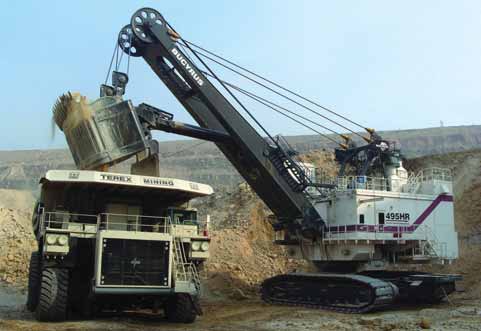
Bucyrus will announce a new generation shearer, the Electra 3000 Evo with advanced automation and productivity features. While keeping successful design features, Bucyrus reviewed all shearers in service around the world to refine the design. The result is a mature, flexible easy-maintenance shearer with further enhanced productivity. The ranging arm has been reengineered to make it more compact— increasing power density and minimizing disruption of material flow on the armored face conveyor. The downdrive, which is also fully modular and easy to access for maintenance, has also been redesigned to reduce maintenance time. The shearer will not be exhibited at the show, but videos and displays will illustrate the benefits.
The company will display a special roof support that can be retrofitted for Longwall Top Coal Caving, a technology being pioneered by Bucyrus in Australia. With a support capacity of 1,362 mt (1,501 tons), the roof support is controlled by PMC-R. The Narrabri roof support exhibit features a video camera system for visual control of the entire face; powerful DN32 hydraulics for fastest advancing times; and height measurement with inclinometers.
The company will also display PF 4 line pans designed to convey 1,800 mt/h (1,984 tph) and the PF 6 line pans 6,000 mt/h (6,600 tph). Also on display for the first time is the PF 6H, a line pan engineered to support heavier shearers (deadweight > 140 mt) and for future chain generations (52 mm+) and Jumbotrack 3000 haulage system.
Other underground mining technology on display includes the Power Chain, a special flight bar design allows lowprofile pan, drastically reducing surface pressure and chain joint wear; the Intelligent CST (Controlled Start Transmission) system; the PMC-Family with special focus on VibraGuard; and belt systems components.
The company will also use 1:50 scale models to showcase its massive surface mining machines. The Bucyrus 8750 D3 Dragline features AC gearless technology. The revolutionary design incorporates the use of 13,000-hp synchronous motors for the hoist and drag motions, setting this machine apart from its predecessors. The AC technology used, supported by Siemens, provides for reduced downtime, maintenance costs and energy consumption, as well as increased productivity.
Another 1:50 scale model will demonstrate the HydraCrowd, the newest innovation in crowd technology developed for electric rope shovels. A hydraulic cylinder inside the tubular dipper handle replaces rack-and-pinion and rope crowd mechanisms, allowing the dipper handle to rotate, thereby eliminating harmful torsional stresses incurred during the digging motion. HydraCrowd is available on new Bucyrus 495HR/HF rope shovels, or as a retrofit option for existing Bucyrus rope shovels.
Other surface mining technologies on display include the LatchFree Dipper System and rotary drill technology such as the Rotary Bit Change Carousel, a Forked Pipe Wrench, a reinforced 49 series drill mast, a 24 volt control system conversion, and an enhanced operator’s cab.
Cummins Highlights Power
for in Mining Equipment
The 3,500-hp rated QSK78 mining
engine will lead the Cummins lineup.
The presence of the 78-liter engine will
highlight Cummins’ position as a leading
supplier of high-powered engines for
large mining haul trucks and excavators.
The V-18 configuration QSK78 was the first engine to bring a 3,500-hp (2,610 kW) power capability to ultraclass mining haul trucks operating at high altitudes. The QSK78 was also the first engine of its size to feature a fullauthority electronic management system, enabling engine parameters to be customized to precisely match the duty cycle of the equipment. The QSK78 continues to set standards in terms of life-to-overhaul and lowest cost per ton, according to the company.
The Cummins mining display will also feature cost-saving technologies for the mine operator, such as the Eliminator self-filtration system, which replaces disposable oil filters on the engine and enables oil change intervals to be extended up to 1,000 hours.
Ranging from 19- to 78-liter displacement, the QSK family of diesel engines is uniquely designed for mining equipment and, according to Cummins, they can handle high-hour and high engine load factors on a fuel-efficient basis and achieve uptime levels of more than 95%.
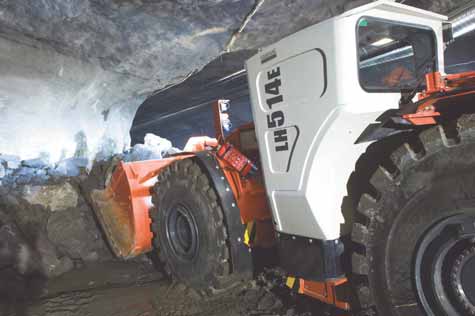
Similar to all Sandvik loaders, the 14-mt eLHD incorporates key features of the recently launched diesel machines, such as upgraded cabin design and Vehicle Control and Management system (VCM). The electronic control system incorporates a state-of-the-art user interface with enhanced diagnostics and a platform for Sandvik’s Automine technology, plus an upgraded electric system designed to interface optimally with the electronic control system.
According to Sandvik, specialty upgraded electric and hydraulic systems and improved tramming capacity deliver excellent productivity, reliability and performance. Offering extended operating range with up to 400 m of cable, they are ideal for use in all applications where the hauling distance is short and operations are repetitive.
Easy to service and maintain, eLHDs also offer reduced downtime by improved diagnostics and troubleshooting with the VCM system. Additionally, new, top-notch manuals and up-to-date training materials make them perfectly suited for all global users with reasonable operational and management practices as required for electric fleet.
Higher productivity is offered with electric motor’s peak torque, resulting in faster bucket filling and better acceleration. The electric model features 14,000 kg (30,865 lb) of tramming capacity, buckets ranging from 4.6 m3 to 7 m3, three-phase, squirrel-cage 45 kW pump and 132 kW drive motors with Dana 5000 series gearbox and Posi Stop axels. Sandvik eLHDs features include better visibility with horizontal cable reel, better fire safety so there is no need for flammable diesel fuel, no hot engine parts and no exhaust fumes.
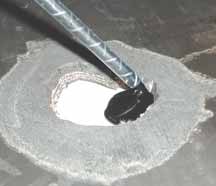
The overall goal is to examine known cost drivers more closely and influence their effects on operating or company results in a positive manner. TCO is, however, also a suitable aid in identifying hidden costs, preferably before an investment decision is made. Moreover, TCO permits a further, much more important examination perspective, namely that of increased use and effectiveness, in this sense almost identical in its meaning to that of the term ‘added value.’
In addition to TCO, Rema will also showcase some new products at bauma. The company has developed Rema- Starm a high-quality wear-protection material which is impressive because of its manifold features. The lining material is based on a thermoplastic polyurethane. It is extremely resistant to wear. It shows a very high grooving and cutting resistance. It stays flexible at extremely low temperatures. It is resistant to oils, greases and a wide variety of solvents. Its high aging resistance is a further advantage.
Rema Goo is a new product which helps to speed up conveyor belt repairs. It is a specifically designed solvent-free two-component polyurethane repair paste which makes it possible to repair damage to conveyor belts in an extremely short time. The material stays elastic. It shows no signs of fatigue or aging. It does not shrink after application and is resistant to UV-rays. It hardens to approximately 60 Shore A, which equals the hardness of conveyor belt rubber covers.
Rema recently acquired shares in Dunlop Industrial Products, South Africa, a major belting supplier. The company is now able to supply high quality conveyor belting to clients across the globe.
Wirtgen Presents the
Largest Surface Miner 4200
In 1980, Wirtgen built the first surface
miner for opencast deposits. Today,
Wirtgen is the market leader in this segment,
offering a technically mature
product portfolio for opencast mining
that has been tried and tested in operations
around the globe. The latest
machine, the large 4200 SM, has a
total weight of more than 200 mt and a
length of more than 30 m. The huge
mining machine is the heaviest and
longest exhibit of the entire Wirtgen
Group exhibition stand.
The 4200 SM is the largest of three Wirtgen machines for opencast mining. Cutting widths range from 2.20 m to 4.20 m and cutting depths of between 20 cm and 83 cm. Wirtgen is the only manufacturer covering a scope of performance ranging from 100- to 3,000-mt/h.
The new 4200 SM is a high-performance machine suitable for mine operators and customers in large-scale opencast mining whose goal is to achieve an annual mining capacity in soft rock of up to 12 million mt while wanting to make full use of the benefits offered by Wirtgen’s selective mining technology that enables cutting, crushing and loading in a single working pass.
The 4200 SM is available in two configurations for operations in either hard or soft rock. For applications in soft rock with unconfined compressive strengths of up to 50 MPa, the 4200 SM is equipped with a 4.20 m wide cutting drum unit with larger cutting diameter, thus permitting a cutting depth of up to 83 cm. The largest Wirtgen miner can alternatively be equipped with a drum assembly offering a cutting width of 4.20 m and a cutting depth of 65 cm for applications in hard rock with unconfined compressive strengths ranging from 30 MPa to 80 MPa.
The heavy-duty machine is equipped with a 16-cylinder diesel engine from Cummins, making it the ideal candidate for a wide range of applications as its power of 1,194 kW offers tremendous reserve capacity. Generously dimensioned tanks offering capacities of 2,900 liter for diesel and 10,000 liter for water additionally increase the miner’s uptime.
A two-stage conveyor system with 1,800 mm wide primary and discharge conveyors and optional discharge conveyor lengths of 12- or 16-m supports the surface miner’s impressive cutting performance of up to 3,000 mt/h. The conveyor’s large slewing angle of 180º, flexible height adjustment and variable conveyor belt speed ensure smooth loading of large transport trucks even in restricted space conditions.

The 4200 SM at the Cloudbreak mine in Western Australia. The powerful Wirtgen surface miner is operating in iron ore, achieving daily production rates of 12,000 mt per shift.
Putzmeister Pumps Tailings
and Fly Ash
Putzmeister Solid Pumps GmbH will
display a high-pressure resistant, upgradeable
high-density solids pump
(HSP) for transporting building materials
underground. The HSP 25150 SP is
a large-volume pump with two individually-
controlled pistons. PSP specifically
designed the pump to convey tailings
and to pump fly ash over great distances.
To achieve as constant a delivery
as possible without pressure peaks,
Putzmeister can, on request, equip
these mining pumps with Pressure
Constant Flow (PCF) control.
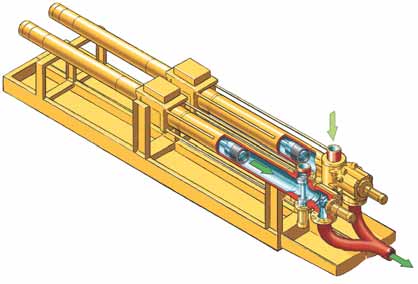
When switching from pressure stroke to suction stroke, seat valves in the HSP pump head with extremely accurate closing characteristics prevent the conveyed material from flowing back out. This means pressures of 150 bar are possible in continuous operation even when pumping paste-like and highly viscous media with small particle sizes. The new seat valve pump for solid matter is designed with a maximum 20 mm diameter. Thanks to the high-volume delivery cylinder, the HSP 25150 SP achieves effective outputs of approximately 250 m3/h—depending on the material to be conveyed and the fill level of the delivery cylinder.
If the output needs to be further increased, the HSP can easily be modified into a multi-cylinder delivery unit. Any number of cylinders is possible with evenly offset piston strokes. The result is a pump system designed to suit each individual delivery job, with an impressive, extremely even output flow rate at high pump outputs. Putzmeister also offers subsequent “upgrading” of the pump installation in order to produce a higher delivery rate.
Grindex to Launch New
Submersible Pumps
A world leader in electrical submersible
pumps, Grindex has implemented some
aggressive changes over the last three
years. In 2007, the company moved into
new facilities in northern Stockholm and
began updating its business systems.
The update process also included the design of a completely new pump series; the fourth generation in the company’s history. The new pump series was introduced to the market in the first quarter of 2008. Compared to earlier pump generations, the pump’s wear resistance has been tripled, in some applications even more. This has been achieved by preventing abrasive particles from reaching the vulnerable parts of the pumps, minimizing wear. This makes the pumps capable of maintaining capacity while operating in really demanding applications.
At bauma 2010, a new generation of slurry pumps will be introduced to meet the needs for extra abrasive resistant submersible pumps. The series will comprise nine pump models with motor sizes from 5 to 70 kW. The company will also introduce a new submersible drainage pump Master SH. The pump has been designed to deliver water up to over 80 m in one single step. This is possible thanks to the double stage impellers. The Master SH pump is ideal for operation in deep excavations where high head pumping is common, such as in underground mines as well as in open-pit mines.
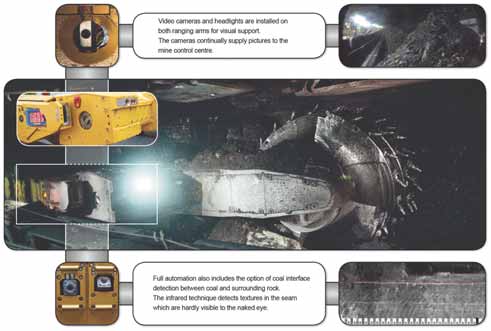
With the automated Eickhoff SL 750 EiControl, the longwall shearer is equipped with capabilities that allow it to see, hear and feel, according to the company. The EiControl senses are derived from features, which are designed for the harsh, potentially explosive mining environment, that include detection of the deposit boundaries by fiber-optic infra-red (IR) cameras with image processing, structureborne noise sensors with specific parameter evaluation, monitoring of the surroundings, the anti-collision facility of the shearer using a specifically developed millimeter wave radar, and visual cameras combined with comprehensive machine diagnostics for online evaluation of the machine state.
The sensor information is evaluated by a system of algorithms and processed into control information for the navigation of the system and the automatic sequence of the mining process. EiControlPLUS is subdivided into logical partial systems which are the haulage automation and the extraction (ranging arm) automation. The haulage automation automates all motion sequences along the face during the extraction pass and includes haulage direction and speed, changes in direction, conveyor overload protection, collision warning and avoidance.
The extraction automation controls the positions of the extraction units (cutter drums) such that the mining system follows the deposit boundaries, avoiding unnecessary extraction of undesired surrounding rock.
One essential feature of the system is the open communication structure where the system’s measuring data can be transferred online to the mine control center, and control and navigation information vice versa, through open and compatible communication paths.
This approach to shearer loader automation brings about considerable advantages in terms of sustainable extraction of raw material, and of hard coal in particular. The operators can be relieved from active control tasks in the highly stressful surroundings of the machine and focus on the monitoring and optimization tasks for the system. The EiControl system also aims for achieving the highest possible predictive utilization of the system components while eliminating unnecessary downtime as far as possible. The mining system also automatically orients itself to the deposit boundaries (horizontal control) and improves the product quality by avoiding cutting of undesired surrounding rock.
This technology was developed through cooperative efforts between the machine builder, Eickhoff Bergbautechnik, the mining company, RAG-Deutsche Steinkohle, and RWTH Aachen as the research institute. The system has been in operation since July 2009 at the Auguste Viktoria mine, near Marl, Germany.
Dana Develops Drive Train for Wheeled Loaders
At bauma this year, Dana will introduce an optimized drive train
solution for 16-mt (17.5-ton) front-end loader vehicle applications
through a system that includes a Spicer 319 summing
motor, two Spicer Model 114 planetary drive axles, and the
Spicer Compact Series Model 2035 driveshaft.
The Spicer 319 summing motor transfer case provides maximum tractive performance and high efficiency. Targeted for applications requiring 104 to 164 kW (140 to 220 hp), this transfer case employs two hydrostatic motors each with optimized gear ratios. To maximize efficiency at higher vehicle travel speeds, a clutch automatically disconnects the low-speed, high-gear-ratio motor, allowing the high-speed motor to function alone. The Spicer 319 summing motor transfer case delivers seamless continuous variable transmission (CVT) performance from 0 to 40 km/h (0 to 25 mph).
The Spicer Model 114 drive axle includes a limited-slip differential lock that provides a 45% locking capacity, delivering excellent tractive force and nimble vehicle steering for frontend loader applications. The Spicer Model 114 axle can be configured with a variety of other hydraulic-locking differential options, including dog clutch and multi-disc clutch. Inboard wet disc brakes offer proven fail-safe stopping performance and energy absorption, while a fail-safe park brake featuring internal negative SAHR is available as an option.
The Spicer Model 114 axle includes 6.00-to-1 ratio outboard planetary wheel ends with 425 mm wheel B.C. mountings, self-adjusting internal wet brakes, and a trunnion mounting option.
Takraf Displays Mobile Crusher
and Surface Miners
Results of recent feasibility studies conducted for overburden
removal systems show an overall life cycle cost which clearly favors In-Pit Crushing and
Conveying Systems (IPCCs) employing
mobile crushing plants, conveyors and
mechanized spreading equipment over
other solutions such as haul trucks. In
2009, Tenova Takraf supplied and commissioned
a mobile crushing plant
rated at 12,000 mt/h for a coal mine in
Queensland, Australia.

Starting from this concept Tenova Takraf embarked on the development of a more simplified plant without the need of the slew function of the entire superstructure. The result is the Takraf mobile crushing system (TMCS) which is now offered as a modular system for a capacities range of about 4,000 to 12,000 mt/h. It may be combined with a belt wagon or a mobile conveyor bridge which is capable of spanning up to three benches of 15-m height or more, from one face conveyor. The TMCS can be equipped with either a double roll crusher or with a sizer.
During December, two Tenova Takraf TSM 300 surface miners began production at HWE Mining’s Yandi iron ore mine in Western Australia.
During the initial start up and training period the cutting capacity averaged 480 mt/h to 1,110 mt/h depending on the material’s compressive strength.
The TSM 300 uses a front cutting drum with a direct twin drive. That allows for a cutting depth of 800 mm. Due to its specific cutting drum design with top-down cutting, the surface miner consistently produces a small product size, without additional crushing. Standard features include a spacious operator cabin with two full size access ways and a trainer seat. It’s advanced on-board machine monitoring and diagnostic system with full size screen and clear text messaging allows for easy control and adjustment of machine parameters for best performance under changing ground conditions.
Atlas Copco Debuts
Equipment and Services
Atlas Copco’s will display its Minetruck
MT42 at bauma, which represents the
company’s next generation of underground
trucks. This high-speed 42 metric
ton (mt) articulated truck has been
designed to maximize productivity as
well as provide increased safety and
operator comfort in underground haulage
applications. The MT42 is available
now in Scandinavia and Canada and will
be launched globally in 2011.

Operator comforts in the standard ISO ROPS/FOPS certified cabin include an air suspended forward-facing seat, a clear, multifunction display monitor, air conditioning and a trainer’s seat. The operator’s sound exposure is below 80 dBA in the cabin. Front axle suspension further contributes to operator comfort, while also allowing greater speeds on mine roadways.
An extensive, 12-month field test at Boliden’s Garpenberg mine in Sweden proved the capabilities of the MT42, while also winning praise from the operators. The articulated steering increases maneuverability and allows agile cornering, while the dump system can discharge a full load in just 13 seconds. Rear facing cameras, one backup camera and one loading camera covering the box, complement the operator’s view from the cabin.
In addition to the MT42, Atlas Copco will also have a Simba S7 D, which is now available for long hole drilling in the small to medium range drift size. Compared to its predecessor, the Simba S7 D provides several features such as: higher ground clearance; Tier 3/ Stage IIIA diesel engine; faster tramming speed; modern design; parts commonality, and the potential to carry a water hose reel.
The company will also introduce a new hydraulic rock drill, the COP 3060MUX, for use in underground longhole drilling. Thanks to a new manufacturing technique, the Atlas Copco designers have been able to minimize losses in the hydraulic flow by optimizing the design of the channels and spool valve. This results in very high efficiency, according to the company.
Atlas Copco is also launching a global training program for drill rig operators. Called Drill Master, it is an intensive training program consisting of three levels—Bronze, Silver and Gold— with built-in qualifications enabling trainees to advance to the next level. The program combines theory, handson simulated training and training in real working conditions.
The company’s Scooptram ST7 recently received top marks during field tests in Sweden, confirming major advances in performance, productivity, serviceability and comfort. It has been undergoing field tests at the Lovisa lead and zinc mine in central Sweden for almost a year and has passed all of its trials by a wide margin.
The Scooptram ST7 has a tramming capacity of 6.8 mt, articulated steering and an oscillating rear axle. It is powered by a clean burning, 193 hp 6.7 liter Cummins Tier 3 engine and benefits from traction control to increased loading performance and improved tire life. A loadsensing hydraulic system increases traction and improves fuel economy. Key safety features include SAHR brakes, automatic brake testing with diagnostics and logging and an oil-free cabin environment. Safety is further enhanced by three emergency machine stop buttons and a system that applies the brakes, blocks steering, and prevents bucket movement when the cabin door is open.
Duferco Clabecq Supplies
High Quality Steels
Manufacturers using abrasion resistant
steel to produce heavy machines are
looking for light steel components offering
longer life cycle and less replacement.
As they enable weight reduction,
demand for these special steels is
increasing. Duferco Clabecq is fulfilling
this specific need with “Quard,” its new
abrasion resistant steel. Thin and wide,
its plates innovate by their consistency
regarding workability, their surface finish
and their flatness.
Consistent mechanical characteristics make it easier for the manufacturers to cut, bend and weld steel plates. With constant mechanical aptitudes and thanks to tight tolerances, processing is achieved faster and more efficiently. Quard’s consistency matches manufacturers’ needs for easy processing.
The excellent surface finish is a direct consequence of Duferco Clabecq’s rolling process, combining a reversed quarto mill and a 4-stand finishing mill, next to which an accelerated cooler has been installed.
With maximized control on production parameters and thanks to its newly commissioned leveler, Duferco Clabecq is able to supply plates with flatness in accordance to the highest standards (EN 10029, class S).
Duferco Clabecq supplies Quard today with a hardness of 400 and 450 Hb in a thickness range between 8 to 20 mm. As a result of an investment of about €100 million, Duferco Clabecq will extend its range of Quard with thickness from 3 to 40 mm and with hardness up to 500 and 550 Hb. Duferco Clabecq has invested in the latest technology tools with enhanced precision to ensure a sustained productivity while delivering plates with accurate flatness and superior surface finish.
Duferco Clabecq is a leading manufacturer of medium and heavy steel plates in thickness range from 3 to 120 mm. It produces high added value steels including structural, shipbuilding, pressure vessel, high strength and abrasion resistant steel as well as plates for pipes. Based in Ittre (Belgium), the company has a yearly production capacity of 750,000 mt. It is a part of Steel Invest & Finance, the joint venture between NLMK (Russia) and Duferco (Switzerland).

Designed for operating in 2.5- x 2.5- m headings, the wheeled loader has a loading capacity of 2.5 m3/m. The 7HR features two unique digging arm systems— digging arms or rotating backhoe— to load the spoil/muck from the tunnel face directly onto the Häggloader’s conveyor, which fills the haulage vehicle with a constant supply.
The conveyor can be raised and lowered to suit the loading height of the different haulage vehicles. The backhoe version can also be equipped with a hammer for scaling the blasted profile. The option of electric or diesel power source is offered for the Häggloader’s hydraulic system and for tramming and transportation.
The hydraulic system can be powered by a 45 kW electric motor or a Stage III Deutz 58 kW diesel engine including a silencer and catalytic converter. The electro-hydraulic drive provides low installation and energy costs and maintains high air quality due to the absence of diesel exhaust. Diesel-hydraulic drive is used for transportation and also minor digging operations. Featuring a 4-wheel traction pull of 7,200 hp, the 7HR also offers front and rear axle steering for excellent agility plus the ability to travel sideways in confined spaces.
SSAB Envisions a Stronger,
Durable World
SSAB produces steels that are among
the strongest in the world. This enables
customers to make lighter, stronger and
more durable products, which offers
major environmental benefits to customers
and the surrounding world.
SSAB is a leading producer of high
strength and quenched and tempered
steels. The SSAB product brand name
portfolio includes numerous brand
names as well as a few rising brand
names, such as Hardox, Domex, Weldox,
Docol, Armox, Prelaq and Toolox.
The properties of the products in terms of strength, abrasion resistance, wear resistance, bendability, weldability, etc. have led to its established strong position in the market. SSAB steels enable customers to manufacture products that are lighter, more durable and stronger than products made of traditional steels.
SSAB was founded in 1978 by the merger of three Swedish steelmakers. But the steelmaking expertise at SSAB is much older than that. The Swedish steel companies that merged into SSA trace their origins to the end of the 19th century and the beginning of the 20th century. SSAB decided at an early stage to become a niche player in steel sheet and heavy steel plate. SSAB advanced high strength steels are characterized by a combination of high strength and toughness, which is due to the purity of the steel and a unique production process. In 2007, SSAB acquired the North American steel company IPSCO, which has two modern heavy plate steelworks. As a result, SSAB now also has a strong presence in the North American market.
After five years of development, SSAB will debut its new WearCalc 2.0 software at bauma. The software allows mine engineers to quickly and easily calculate the relative service life of abrasion- resistant spare parts. Combined with comparative material and production costs, this allows quick selection of the optimum materials for the job.
Material price and manufacturing costs are relatively easy to establish. But predicting the service life for various materials under different conditions is much trickier. The former version of WearCalc only predicted sliding wear. WearCalc 2.0 also predicts erosive and impact wear as well as sliding wear for all types of Hardox wear plate. Development of the impact wear model required extensive testing both in the laboratory and at a range of industrial sites. The model covers two types of impact damage: Severe damage involving crater formation and extruded lips during impact, and milder damage resulting in plastic deformation of the surface.
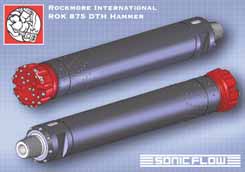
A patented, streamlined design also takes full advantage of the company’s unique SonicFlow technology, which optimizes airflow by simplifying the air path. Every time the airflow changes direction, energy is lost through turbulence. With fewer obstructions, more energy is delivered to the piston while minimizing back-flow interference. Smooth radius ports were added in the airflow chambers, which minimize energy losses even further, which means faster penetration rates and greater overall efficiency.
Godwin to Debut New Dri-
Prime Pump
In celebration of the 40th anniversary of
the Dri-Prime pump, Godwin Pumps
will debut their newest HL Series addition,
the model HL260M Dri-Prime
pump, at bauma 2010 in Hall A6,
Stand 406.
The HL260M is a 250 mm x 200 mm (10-inch x 8-inch) single-stage automatic priming centrifugal pump capable of flow rates to 910 m3/h (4,000 gpm), heads to 183 m (600 ft) and solids handling to 60 mm (2-3/8 inch). Built with a cast iron pump volute, cast chromium steel impeller and nickel chrome cast iron wear plates, the HL260M is engineered for tough pumping applications.
The Dri-Prime venturi priming system on the HL260M provides suction lift capability to 8.5 m (28 feet) and continuous uninterrupted operation, even in intermittent dry suction conditions. In addition, its dry running, double high-pressure oil bath mechanical seal with abrasion resistant solid silicon carbide faces enables the pump to run indefinitely without risk of overheating or failure.
The HL260M is offered with several engine options, including the standard 600 hp Caterpillar C-18 Tier 3 diesel engine. Mounted on a skid, the HL260M is built with an integral bundled fuel tank to provide hours of continuous operation and spill protection.
Volvo Pulls Out All the Stops
Volvo will unveil innovative new products
and services under the guiding
themes of being a global leader in fuel
efficiency and a provider of total solutions
to customers. In addition to a
range of more than 60 machines on the
stand, including highlights of the substantial
fuel saving provided by the
‘OptiShift’ technology fitted to the new
L150F, L180F and L220F larger wheel
loaders. Volvo has made a commitment
as a total solution provider; a comprehensive
range of products and services
designed to carry each machine through
a long and productive life.
The company’s presence at bauma will be divided into a 2,454 m2 indoor display area and a 7,410 m2 outdoor demo zone. The indoor area will feature static new products and much of the space will be given over to the company’s growing portfolio of service offerings. The Volvo event team will be primed to deliver all of the ways Volvo dealers can work with customers to improve productivity, maximize machine uptime, reduce risk and take greater control of costs. The outdoor portion of Volvo’s exhibition space is more practical in nature, with the central area dominated by a demonstration arena.
Eirich Believes in a
Quality Mixture
Eirich has played an active role in the
development of industrial mixing technology
for more than 100 years. The
company’s large number of patents, its
close cooperation with users, and the
partnerships with research and learning
institute have laid the foundation for
the excellent reputation of the Eirich
intensive mixers.

Deutz Offers More Flexibility
The Deutz stand, measuring more 400
m2, will feature an extensive range of
engines to meet the more stringent
demands of the Tier 4 Interim/Tier 4
Final emissions standard and will offer
existing and prospective customers a
comprehensive portfolio of exhaust gas
after-treatment components.
A particular highlight, which Deutz is presenting under the provisional model designation of TCD 20XX, is a completely new engine developed for the construction industry. This ultra-compact, 2.9 liter cubic capacity, four-cylinder in-line engine was specifically developed to meet the requirements of 28 to 55.9 kW power range. The 20XX engine has been cleverly designed to not exceed the 56 kW threshold and does not need a diesel particulate filter nor its associated complex regeneration technology. For most applications, it only needs a diesel oxidizing catalyst (DOC), an inexpensive and easy-toinstall exhaust gas after-treatment system to meet Stage IIIB and Tier 4. The optional attachment components for the 20XX have been designed to offer customers more flexible installation options and significantly lower installation and operating costs.
For the higher power range, Deutz is presenting the TCD 2013. Producing 160 to 250kW at 2,200 rpm, this liquid- cooled six cylinder in-line engine features ruggedness and high performance. The TCD 2013, equipped with charge-air-cooled turbocharger, cooled external exhaust gas recirculation and diesel particulate filter, satisfies the emissions standards for mobile working machines in accordance with the EU Non-Road 2004/26 Directive, EU Tier IIIB and U.S. EPA Tier 4 Interim. It benefits from the Deutz Common Rail high pressure injection system, electronic engine control allowing intelligent engine management adjustments, plus integral power take-off options during wheeled operation. The lean engine construction and variable design of the front end of the engine have resulted in maximum flexibility. Fuel economy figures, simple and inexpensive installation and long service intervals also make for great economic efficiency. Low noise emissions ensure further cost savings as regards sound attenuation measures.
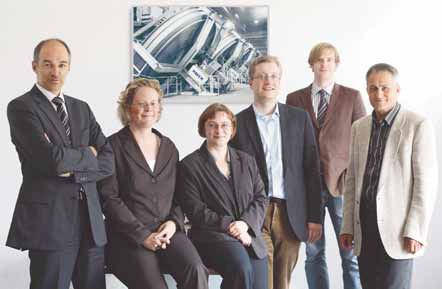
The company is also presenting its subsidiary company Haver Engineering Meissen (HEM) from Saxony in Hall B2 at Stand No. 131/232. HEM is the engineering office to contact for complex jobs, according to H&B. In early 2009, HEM was recognized as an official associated institute of the Technical University Bergakademie Freiberg in Germany. This highlights HEM’s technical capability as an associated institute, an independent facility which works closely with universities in teaching and research. With this groundbreaking step the latest scientific findings are now brought into project work. The team of experienced engineers and specialists extends to scientists at the Technical University and taps into new resources.
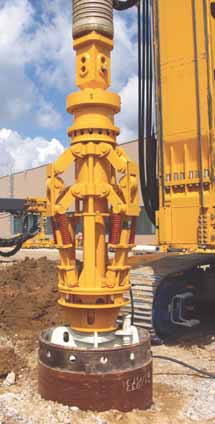
The company also submitted its down-the-hole (DTH) flushing system for an Innovation Award. Upon reaching a rock layer, the newly developed DTH flushing head can be used together with a roller bit drilling tool to improve the drilling process.
GHH Fahrzeuge
GHH Fahrzeuge along with its subsidiary
Mine Master Poland and its sister
company Hazemag & EPR, will showcase
their highly innovative products for
mining and tunneling (Hall C2, Booth
315/412). GHH Fahrzeuge will display
the LF-10/11 LHD with an 11-mt payload
(in a 10-mt shape) and 5 m3 bucket.
This machine is equipped with an
Efficient Drive System (EDS) drive train
that combines a hydrostatic drive with a
multiple-gear transmission and mechanical
power transmission to wheels and
axles. It has completed extensive trials
in Germany and South America. The
complete speed range of 0-25 km/h is
passed through automatically.
The LF-10/11 complies with the latest EU regulations whereby it is equipped with a COM III engine and an air conditioned cabin designed to ROPS/ FOPS standards. The LF-10/11 is characterized by lowest fuel consumption and lowest emissions. The bucket filling process is very efficient as the complete engine drive is allocated to the forward motion when moving into the muck pile. The productivity of the LF-10/11 is significantly higher than to any other comparable LHD with the benefit of fuel savings of up to 15%.
GHH Fahrzeuge’s product portfolio covers LHDs of 4.5 mt up to 20 mt payload as well as dump trucks of 15 mt to 50 mt payload.
Hazemag Displays
Crushing Technology
Hazemag is exhibiting its latest crushing
equipment at bauma 2010—the
new Sand-Impactor APKV and the
VarioWobbler wobbler feeder—at Stand
129/230 in Hall B2. The completely
overhauled and updated sand impactor
has a capacity of 50 to 120 mt/h. Four
generously-sized doors provide full
access to the internals to optimize servicing
and maintenance work. The blow
bars are inserted laterally to permit
quick and easy turning and replacement,
and the impact aprons have an easy-to-use push-button hydraulic
adjustment system. The housing is
lined with manageable, easy-to-change
wear plates. The sand impactor can be
deployed both as a secondary or a tertiary
crusher, to generate a product ranging
from coarse to fine. Based on a feed
size of up to 100 mm, gravel, granite,
basalt and even slag can be processed
to generate mechanical sand or fine
and coarse chippings with minimum
filler content. Optimum feed material
distribution is achieved over the whole
width of the rotor with the Vibro-feeder
to ensure even wear of the blow bars.
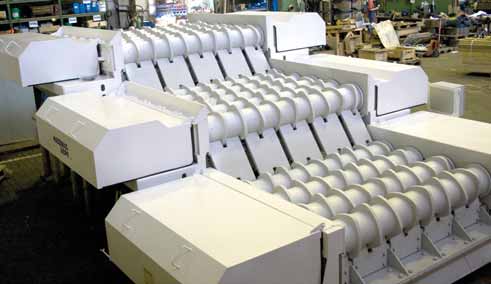
In the outside area in front of Hall B2, the mining team is displaying one of its bigger crushers, the Horizontal Roll Crusher FB1111. This crusher can be used for gypsum, potash, coal and many softer minerals at feed sizes of up to 1,500 mm with throughput rates of 1,000 mt/h. The other brands can be found at Hall C2 stand 315/412 where the versatile EL 160 dinting loader equipped with a hydraulic rock breaker will be displayed together with the newly-developed version of the EL 160 LS with a gun-mount for blasthole and anchor borehole drillings. The EL 160 series, used in the coal mining industry worldwide, has a compact design for application in narrow spaces. Five hydraulically driven impact chisels are integrated in the bottom of the box-type bucket for crushing rock fragments. An alternative to the bucket is a hydraulic rammer for jobs such as loosening rock with a high compressive strength or crushing large blocks.
Mine Master to Unveil
Drill Rig
A new drill rig from Polish manufacturer
Mine Master, called Face Master 2.3,
will be unveiled at bauma. Designed for
mining applications, the small twinboom
jumbo measures 2.3-m high and
is equipped with many new applications
that will enable an increase in
productivity, reliability and safety. The
new diesel engine reduces emissions.
The unit has an electrical system
equipped with soft-starting to reduce
the input of electricity by more than
20%. An improved hydraulic system
reduces vibration and provides better
control. The system allows the operators
to adjust for different rock formations.
It can also reduce the amount of
consumables (bits, accessories, etc.) by
as much as 30%. A low-emission 95-
kW diesel engine makes allows operators
to tram the system even in poor
underfoot conditions. The operators are
working safely inside full FOPS/ROPS
protection. A Canbus system has been
designed to assist fault finding for
maintenance technicians.
Orlaco Offers
Monitoring Solutions
Orlaco (Stand A3.501) will present its
newest camera/monitor solutions for
off-road equipment, including the
Spectrum scanner, a radar system, the
Compact Pin Hole (CPH) and the panand-
tilt Zoom cameras.
The Spectrum scanner auto-searches for the optimum frequency for data exchange between camera and monitor. The system selects its frequency from up to eight different frequencies. The driving force behind this development was the need for highly reliable and available images, because these features are essential for both safety and comfort.
The company’s new radar system detects objects and persons in the immediate vicinity of a vehicle. If these are identified, the view system automatically switches to the camera on that side of the vehicle. This active signaling represents a significant improvement in safety at the workplace.
Orlaco developed the Zoom camera inhouse. The pan and tilt function is fully integrated into the housing of the Zoom camera. The camera always remembers its last position. In case of uncontrolled camera movements, for example when it is hit by objects, the camera automatically returns to its last position. The CPH camera is mounted on the fork carriage or in the attachments and gives a view of the position of the load.
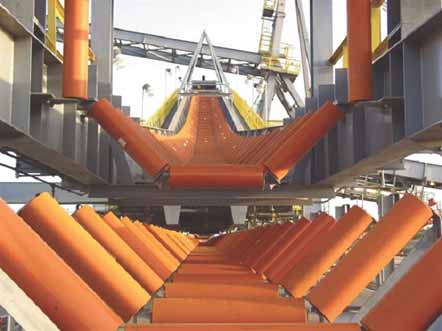
ZF’s AWD Technology
The VG 2000 all-wheel drive transfer
case by ZF is designed for especially
high input torques of up to 25,000 Nm.
Also medium to heavy trucks in construction
site applications benefit from
the features provided by this powerful
transmission: It facilitates the use of a
power take-off and offers the choice
between two different ratios for an offroad
speed and an on-road speed. The
compact structure of the transfer case
leads to a weight optimized design. The
VG 2000 is also characterized by its
reliability and easy maintenance,
according to ZF. These features provide
a particular advantage to fleet owners
who rely on the economical operation of
their vehicles. The transfer case forms a
strong unit with Ecosplit, the 16-speed manual transmission. It provides for
optimal power transmission because of
the differentiated setup of transmission
steps, short shifting travel, very smooth
running and, at the same time, low curb
weight. The compact ball-and-nut power
steering Servocom by ZF Lenksysteme
offers further advantages in handling.
ZF has also extended its axle series MT-L3000 by the three new axle types MT-L3115, MT-L3125 and MT-L3135. Thanks to identical installation dimensions the integration into the vehicle within these three axle types has been highly simplified. In comparison with the previous model nominal torque capacity could be increased by 33%. Due to the fact that axle weight and oil volume increases have been more moderate, the power to weight ratio has been improved. In spite of this the lifetime of axles with expected 15,000 operating hours for heavy duty application could be considerably increased.
Nilos Cuts through Steel
Cord Belting
To cut through steel cord conveyor
belts, miners need the right tools.
Developed specially for the job, Nilos
GmbH will introduce its RotoCut beltcutter.
Nilos supplies two electrically
operated versions, the RCE 20 and the
RCE 40, plus a mechanical version
RCM 20. As the latter is not electrical,
it is suitable for use in underground
mining. The toothed cutting wheel cuts
into the belt from above and in doing so
sets the two lower, smooth cutting
wheels in motion: the belt is cut
through shear action. The teeth in the
upper toothed cutting discs are
arranged in such a way that one steel
cord fits between two teeth, the cord
being sheared as the disc rotates. This
happens also with the manual lever
drive of the RCM 20 which can be operated
without the need for great force;
an amazing feat in view of the thickness
of the steel cables.
